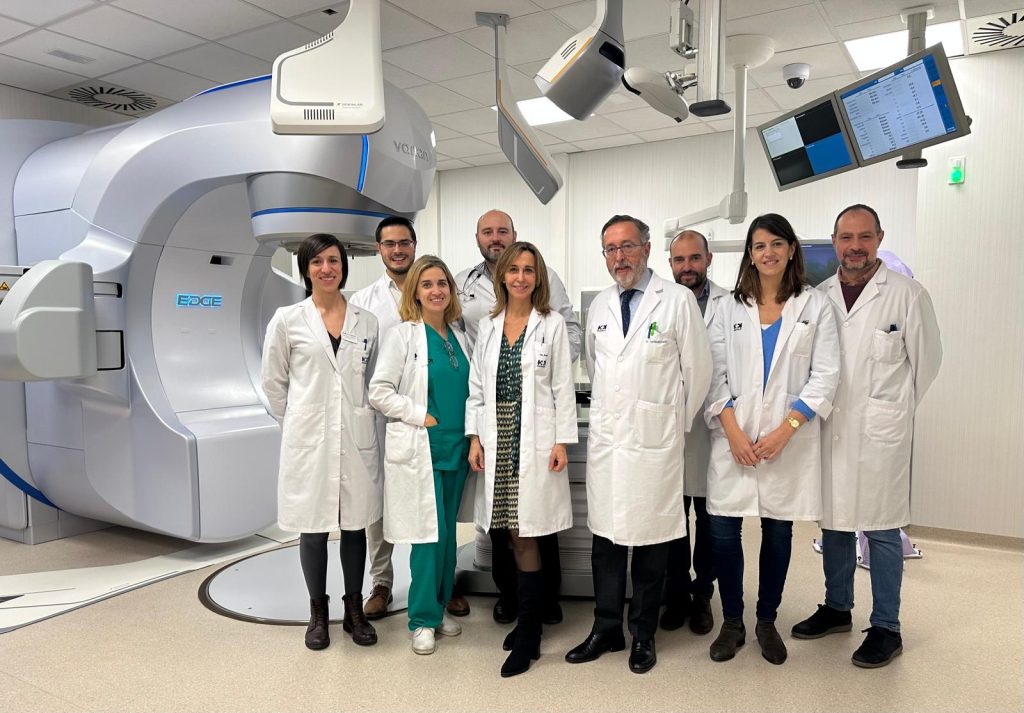• The department is located at the HM Sanchinarro University Hospital and has earned the best reputation in the entire Spanish National Health System (SNS) in 2024, according to healthcare professionals, patients, journalists, and managers.
• The excellence of its team, cutting-edge technology, and commitment to research have been the key factors behind this recognition.
• The department is equipped with the most advanced tools in radiation oncology, including high-precision linear accelerators for cranial and body radiosurgery treatments.
• Key research areas include the use of radiosurgery for multiple brain metastases in a single session, the role of surface-guided radiotherapy (SBRT) as an alternative to surgery in pancreatic neuroendocrine tumours, and its application in high-risk prostate cancer patients and post-prostatectomy cases to improve tolerance compared to conventional treatments.
The Radiation Oncology Department at the Clara Campal Comprehensive Cancer Centre (HM CIOCC), located at the HM Sanchinarro University Hospital, has been recognised as the top-rated department in the Spanish National Health System (SNS), both in the public and private sectors, according to the latest Healthcare Reputation Monitor (MRS) report by Merco, published at the end of 2024. The report takes into account the opinions of healthcare professionals, patients, journalists, and managers.
Dr Carmen Rubio, Head of the Radiation Oncology Department at HM CIOCC and President of the Spanish Society of Radiation Oncology (SEOR), highlighted that this recognition is “the result of the effort and commitment of a multidisciplinary team that has worked together for 17 years to ensure the best care for our patients. The main factor contributing to this recognition is undoubtedly the team of professionals who make up the Radiation Oncology Department.”
Currently, the department includes nine radiation oncologists, six medical physicists, two nurses, three dosimetrists, and ten radiotherapy technicians, as well as support staff. “Our goal is to provide safe, personalised, and high-quality treatment,” said Dr Rubio.
A reference team and advanced technology at the service of patients
The Radiation Oncology Department at HM CIOCC is equipped with high-precision linear accelerators for cranial and body radiosurgery treatments. “The millimetre precision of this technology allows us to concentrate the dose on the tumour area, minimising damage to healthy tissues,” explained Dr Rubio. This translates into more effective treatments, fewer sessions, and a faster return to daily life for patients.
Specifically, the department has the Varian Edge linear accelerator, which includes the BrainLab Exactrac Dynamic system, designed for treatments requiring submillimetre precision, such as brain lesion radiosurgery, trigeminal neuralgia, surface-guided radiotherapy (SBRT) for spinal lesions, and prostate cancer.
The department is also equipped with the Elekta Versa HD accelerator, which features a 6D robotic table and an image-guided radiotherapy (IGRT) system. Additionally, the Exactrac Dynamic system has been a significant advancement, allowing for the simultaneous use of SGRT and IGRT. “The incorporation of these high-precision systems has undoubtedly improved the clinical outcomes of radiotherapy treatments for many tumours, in terms of local control, increased survival, and enhanced quality of life for patients.”
Research
HM CIOCC’s leadership in translational oncology research is part of a comprehensive strategy that combines cutting-edge technology, highly qualified multidisciplinary teams, and a national and international collaboration network, establishing itself as a key institution in the fight against cancer. Under the umbrella of the HM Hospitales Health Research Institute (IISHM) and the HM Hospitales Research Foundation (FiHM), research is a fundamental pillar in the search for more effective and personalised treatments in radiation oncology. Several innovative studies are underway to improve the efficacy, safety, and clinical outcomes for various types of cancer and other conditions. The department actively participates in multicentre studies promoted by national and international cooperative groups.
Currently, there are multiple active research lines covering all pathologies included in the department’s portfolio, with a focus on prevalent cancers such as prostate, breast, and pancreatic cancer. The efforts of the department’s professionals to improve patients’ quality of life have led to the development of new applications and indications for radiotherapy. These results have had a direct impact on patients treated in the department, enabling the development of more effective, safe, and personalised treatments. “We are evaluating the tolerance and effectiveness of using radiosurgery for multiple brain metastases in a single session. In pancreatic cancer, we are assessing the role of SBRT (stereotactic body radiotherapy) as a neoadjuvant treatment to improve tumour resectability and determine its impact on overall patient survival,” said Dr Rubio.
Another research line explores the role of SBRT as an alternative to surgery in pancreatic neuroendocrine tumours, particularly in low-grade cases, to avoid aggressive surgical procedures and improve patients’ quality of life. “We are also investigating extreme hypofractionation schemes with SBRT in high-risk prostate cancer patients and post-prostatectomy cases to improve tolerance compared to conventional treatments,” added Dr Rubio. Research is also being conducted on hypofractionated radiotherapy for breast cancer and the potential benefits of neoadjuvant radiotherapy in high-risk patients to improve clinical outcomes. Additionally, “we continue to evaluate the long-term anti-inflammatory benefits of low-dose radiotherapy for pain management and functional improvement in patients with degenerative osteoarticular conditions.”
The human approach
Finally, one of the most distinctive aspects of the department is its comprehensive and personalised approach to patient care. The radiation oncologists are part of the functional units for various oncological pathologies at HM CIOCC and actively participate in tumour boards and clinical sessions where decisions about the most appropriate treatment for each patient are made. “Our involvement with patients begins with the initial assessment and the indication for radiotherapy, but it goes much further: we maintain continuous follow-up throughout the treatment and during the course of the disease. Ultimately, our commitment is not limited to providing the best radiotherapy treatment but also involves comprehensive, high-quality care, ensuring the well-being and support of patients at every stage of their journey,” concluded Dr Rubio.











